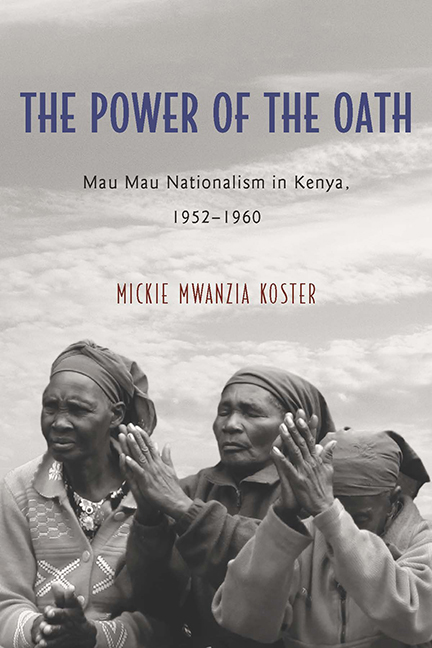3 - The Mau Mau Oath Process and Architecture
Published online by Cambridge University Press: 07 May 2022
Summary
The Mau Mau oath became increasingly more violent and bloodthirsty, it was not surprising therefore that there was a corresponding increase in bestiality in the ritual of the oath, thus forcing the initiate to reach the necessary pitch of blood lust and degradation to make it possible for him to pronounce the ghastly words of the oath itself. These ceremonies were repeated at intervals to spur the recipients on to greater excesses. It is not possible to give any detailed description of these terrible ceremonies.
—CorfieldDespite over fifty years of interest on the topic, the Mau Mau oath remains misunderstood and misrepresented. This chapter, however, uncovers the structure and workings of the experience and why oathing was usable in different forms across different communities during the war. For decades now, since the 1960s, the Mau Mau oath historiography has been associated with “bestiality.” African spiritual unknowns were often classified and simplified as cases of witchcraft or paganism, and the oath was thus dismissed as a form of African power. African power was suppressed during colonial rule as colonial mandates and domination were carried out. Due to the political nature of the Mau Mau war and wide and systematic acceptance of Christianity, there has been a failure to systematically treat, analyze, and communicate the oath phenomenon. The need for an approach to analyze and understand oathing is clear. Thus, this chapter theorizes a way to analyze and interpret the Mau Mau oath's complexity. There are many oath variations and experiences that command analysis in understanding Mau Mau history. To this point, we begin considering the Mau Mau oath experiences of Kaguru Ireri and Muchiri Kagiri who attended the same ceremony.
Many Variations of the Mau Mau Oath: The Mau Mau Oath Case of Kaguru Ireri and Muchiri Kagiri
On the evening of November 13, 1953, Kaguru Ireri heard a knock on his door. He opened the door and was greeted by three armed men; he recognized one of them. Kaguru was seized and forced to get a goat. The four men and the goat went to the hut of an individual identified only by the name Githirunga. Kaguru was being taken to a Mau Mau oath ceremony.
- Type
- Chapter
- Information
- The Power of the OathMau Mau Nationalism in Kenya, 1952–1960, pp. 54 - 78Publisher: Boydell & BrewerPrint publication year: 2016



